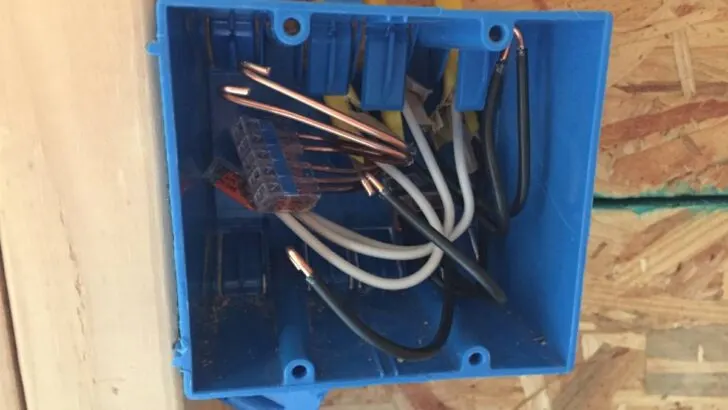There are a lot of misconceptions about that mysterious white neutral wire. One topic that comes up quite often is whether or not the neutral can shock you.
The neutral wire will not shock you under normal circumstances. However, some situations can make the risk of receiving a shock more likely, so caution should always be employed. To reduce or remove the risk of electric shock, assume the neutral wire is as dangerous as the hot wire.
This article will discuss when a neutral wire can shock you, why it would be hot, how to stay safe while working with a neutral wire, and what to do when you find a hot neutral wire. Let’s get going!
How Can the Neutral Wire Shock You?
I don’t like to get superstitious about electricity, but in 30 years of renovation, it’s sometimes felt like electricity has been out to get me. The human body can stand up to 50 volts of electricity relatively comfortably, but I’ve never felt comfortable with an electric shock, and neither should you.
In Wiring 101, we all learn that the electrical load runs through the hot wire to power up the lamp, the toaster, the microwave, or other items, and the energy is converted into light, heat, or sound. However, our appliances require a full circuit to deliver any unused or unbalanced current back to the panel and earth.
Electrical appliances in a metal shed might present an issue if the shed isn’t grounded. Read our article about if metal sheds should be earthed for more information.
What this means is there may well be a small residual voltage traveling the neutral line. Most of the time, this would not be a problem. However, if there is an issue with the circuit, the neutral wire is where I’ll find it. (source)
How do I find it? I always use a circuit tester (link to Amazon) with a clamp meter.
Why Would the Neutral Wire Be Hot?
I’ve been on a number of renovation projects, both domestic and commercial, where someone, at some point, didn’t wire something correctly. It may have been a repair or an addition to a circuit not done right.
All the light switches and electrical outlets worked okay. No breakers tripped out. All the circuits were working, but without testing, I had no idea whether they were working as they should.
If there’s a short circuit, a domestic breaker will usually be sensitive enough to let you know, and it’s likely the first warning you will get of a problem, but sometimes there’s a different story going on.
The breaker board can’t tell you immediately whether all the neutral wires are running independently of each other back to the panel. Sometimes combining or mislabeling these cables is easy, especially in a larger project.
Sure, all the circuits will work, but turning one off won’t be enough protection if they share a neutral with another circuit. It’s possible to turn off all of the power to the supply panel and, in doing so, render all the circuits safe, but most of the time, this just isn’t a practical option, and it won’t solve the problem.
I usually send someone to the panel to turn circuits on and off while I keep the circuit on to see if it makes a difference. If that doesn’t solve it, then it’s time to call an electrician.
This YouTube video does a good job of explaining how a neutral wire can be hot:
What Do I Do if I Find a Hot Neutral?
Chances are that a hot neutral is simply flagging that there’s a loose connection somewhere, which is the most usual cause. Tracing it shouldn’t be too difficult, as it will be along the circuit. When you find it, connect it, and the problem should vanish.
If all the connections are opened and are in good condition, then there’s a possibility that the return cables have been confused at the panel. This is a little more complicated to resolve, and I recommend calling an electrician to deal with the problem.
The other reason the neutral could be hot is that the neutral is broken somewhere along the line, either due to work carried out on the house or possible rodent damage.
I found one circuit with a broken neutral cut neatly in two by a nail. The nail had been removed, but I could see where it had once been. I figured whoever did it must have known, but no one owned up. The previous owner might have done it; who knows?
If PVC cables run through polystyrene insulation, then chemical migration of polymers could also render cables brittle, opening up the possibility of a short circuit.
How Do I Stay Safe From Electric Shock From a Neutral Wire?
The safest way is to treat every wire in the home as if it was hot enough to shock. The neutral shouldn’t carry enough current to cause a problem, but if the neutral line is broken, perhaps disconnected somewhere along the journey back to the panel via another switch or outlet box, there will be trouble.
The current always needs somewhere to discharge back to earth, either at the panel or through an unsuspecting human. An electrical circuit test kit (Link to Amazon) is less than $15, a small price for peace of mind.
I always test every electrical cable I find, wherever it appears. On a renovation job, you can never know where some wires are going or where they come from without getting an electrician to do a thorough test and trace survey.
Summary
It’s always a possibility that a neutral wire could deliver an electric shock, so treat it with respect. Taking maximum precautions is always a good idea, whether the project is a simple switch cover upgrade or investigating why something isn’t working properly.
Using a cable testing kit will save finding out the hard way. Even small electric shocks can be fatal in some cases. My rule is, if in doubt, call out a registered electrician to come and solve the problem so the job can progress safely.

Simon Kellow is a master carpenter with over thirty-five years of experience in carrying out home renovations while running construction projects large and small. When he’s not in the office or fixing something in the workshop you can find him enjoying the great outdoors with his family.

